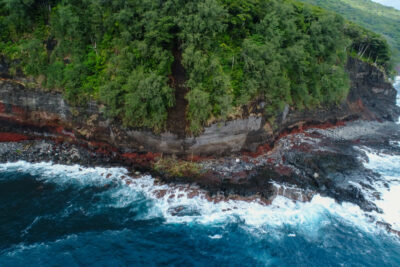The 2022 Hunga-Tonga Mega-tsunami: Near-Field Simulation of a Once-in-a-Century Event
Sam J. Purkis, Steven N. Ward, Nathan M. Fitzpatrick, James B. Garvin, Dan Slayback, Shane J. Cronin, Monica Palaseanu-Lovejoy, and Alexandra Dempsey. "The 2022 Hunga-Tonga Mega-tsunami: Near-Field Simulation of a Once-in-a-Century Event." Science Advances. (2023)
Abstract

The 2022 Hunga Tonga-Hunga Ha’apai eruption generated a once-in-a-century magnitude tsunami.
The Hunga Tonga-Hunga Ha’apai (HTHH) volcanic eruption in January 2022 generated a catastrophic tsunami and contends for the largest natural explosion in more than a century. We present a tsunami simulation of the Tongan Archipelago calibrated by field observations, drone, and satellite data. The main island, Tongatapu, suffered waves up to 17m and Tofua Island up to 45m, comfortably placing HTHH in the ‘megatsunami’ league. Our simulation emphasizes how the complex shallow bathymetry of the area acted as a low-velocity wave trap, capturing tsunami for more than one hour. Despite its size and long duration, this tsunami claimed few lives. Simulation suggests that HTHH’s location relative to urban centers saved Tonga from a worse outcome. Whereas 2022 seems to have been a lucky escape, other oceanic volcanoes possess the capacity to spawn future tsunami at HTHH scale. Our simulation amplifies the state of understanding of volcanic-explosion tsunami and provides a framework for assessment of the future hazard in Tonga and beyond.
Model of Tonga Tsunami
Animation of the tsunami propagation across the Tonga archipelago. Credit: Steven N. Ward – Institute of Geophysics and Planetary Physics, University of California Santa Cruz, U.S.A.